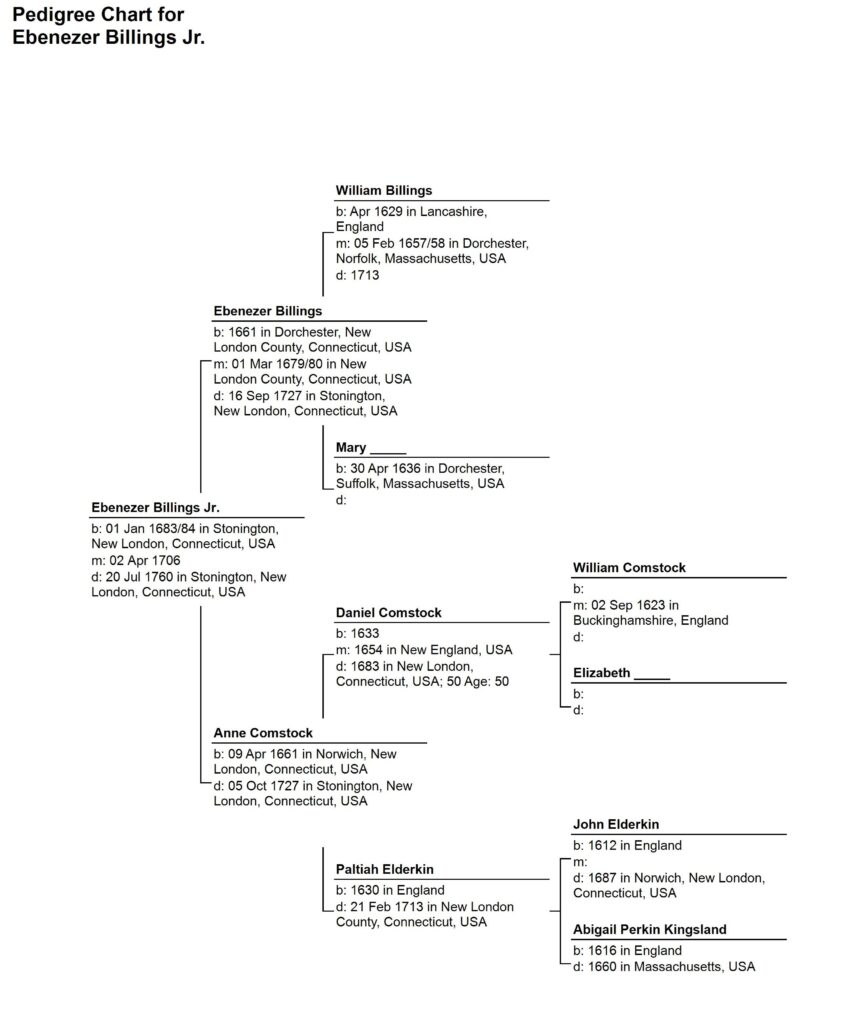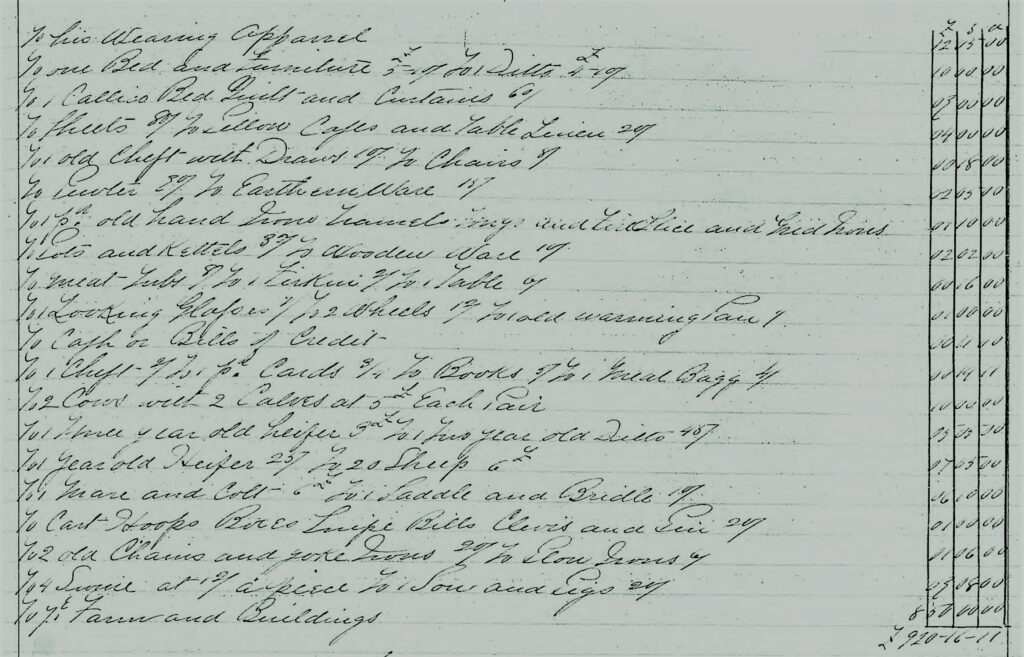A gal needs a break now and then from her regular work, even when she loves her regular work. This is a quick break to explore an ancestor who falls outside of my current project. The ancestor was chosen randomly for a little special attention. Breaks need to have limits, so only a few hours of study and writing were spent on this post. This is just a little introduction to a person whose story is much bigger than what is written here.
Ebenezer Billings Jr. (1683/84-1760)
Lieutenant Ebenezer Billings Jr. lived in Colonial America. During his 76-years of life he lived in Stonington, New London, Connecticut, a town on the shore of the Atlantic Ocean along the Long Island Sound and Block Island Sound, not far from the border of Connecticut Colony with Rhode Island Colony.
Stonington, Southeastern Connecticut COG, Connecticut
How is he related?
Ebenezer Billings Jr. was a 5th great-grandfather of Floyd Boyce Phillips.
Several of his descendants have been featured in earlier posts including his granddaughter Sabra, great-granddaughter Elizabeth, great-great-granddaughter Betsy, third-great-grandson Albert, fourth-great-grandson Guy, and fifth-great-grandson Floyd.
His Phillips descendants have been more thoroughly documented in The Phillips Family book.

A few facts
Ebenezer Billings Jr. was born on 01 Jan 1683/84 in Stonington, New London, Connecticut, as the child of Ebenezer Billings and Anna Comstock. He had at least nine siblings, namely: Anna, William, James, Margaret, Zipporah, Jemima, Increase, Thankful and Benjamin. Ebenezer Billings Jr. was baptized on 11 May 1690 in Stonington, New London, Connecticut.
When he was 22, he married Phebe Denison, daughter of Phebe Lay and John Denison, on 02 Apr 1706.
Ebenezer Billings Jr. and Phebe Denison had the following children:
- Abigail Billings was born on 01 Mar 1706/07 in Stonington, New London, Connecticut. She died on 30 Oct 1789. She married Samuel Prentice on 22 Sep 1725 in First Congregational Church, Stonington, New London, Connecticut.
- John Billings was born on 08 Dec 1708. He died (died young).
- Ebenezer Billings III was born on 20 Mar 1710/11 in Stonington, New London, Connecticut. He died on 03 Jul 1759 in Stonington, New London, Connecticut. He married Mary Noyes in Nov 1733 in First Congregational Church, Stonington, New London, Connecticut. He married Sarah Chesebrough in Connecticut.
- Phebe Billings was born on 04 Apr 1714 in Stonington, New London, Connecticut. She died on 03 Apr 1792 in Stonington, New London, Connecticut. She married Nathan Palmer on 21 Apr 1735 in Stonington, New London, Connecticut.
- Grace Billings was born on 27 May 1716 in Stonington, New London, Connecticut. She died on 23 Jan 1792 in Stonington, New London, Connecticut. She married James Noyes Sr. on 22 Jun 1739 in First Congregational Church, Stonington, New London, Connecticut.
- Anne Billings was born on 21 Jun 1718 in Stonington, New London, Connecticut. She died on 10 Nov 1754 in Plainfield, Windham, Connecticut. She married Simon Spaulding on 01 Jun 1737.
- John Billings was born on 29 Sep 1720 in Stonington, New London, Connecticut. He died on 05 Feb 1761 in Stonington, New London, Connecticut. He married Elizabeth Page on 07 Apr 1743 in First Congregational Church, Stonington, New London, Connecticut.
- Jabez Billings was born on 29 Sep 1720 in Stonington, New London, Connecticut.
- Christopher Billings was born on Feb 1722/23 in Stonington, New London, Connecticut.
- Daniel Billings was born on 10 Feb 1724/25 in Stonington, New London, Connecticut. He died on 01 Jun 1745.
- Nathan Billings was born on 09 Apr 1727 in Stonington, New London, Connecticut. He married Anna Bell on 21 Apr 1757 in First Congregational Church, Stonington, New London, Connecticut.
- Ann Borodell Billings was born on 18 Apr 1732 in Stonington, New London, Connecticut. She died in Feb 1780 in Stonington, New London, Connecticut. She married Oliver Grant on 23 May 1749.
- Nathaniel. He died before 1760.
Ebenezer Billings Jr. died on 20 Jul 1760 in Stonington, New London, Connecticut and was buried at the Great Plain Cemetery in North Stonington, New London, Connecticut. His estate was probated on 09 Jul 1760 in New London, Connecticut. He was buried in North Stonington, New London, Connecticut.
Do we know anything about his ancestors?
According to History of the Town of Stonington, William Billings, a grandfather of Ebenezer Billings, Jr. was the first in the family to come to the Stonington, Connecticut. William immigrated from Taunton, England, settling first in Dorchester and Braintree, Massachusetts. The exact date of his move to Stonington is not known but he built a dwelling-house there on Cosatuc Hill. Land grants and purchases made him a large land owner.
Ebenezer Jr. also had other grandparents and great-grandparents who were immigrants from England to the Colonies with the Great Migration. His ancestors were in North American for more than fifty years before he was born and many were instrumental in setting up churches and communities in New England.

Why was he called Lieutenant?
Ebenezer is referred to as Lieut. Ebenezer Billings Jr. because on 14 Oct 1731 he was given that rank in the Second Stonington Company. Previously, in 1721, he had earned the rank of Ensign.
He also served as the deputy of Stonington in 1721 and 1722. Under the charter of King Charles II, representatives were elected semi-annually. In 1721, Ebenezer served beside Joseph Stanton, John Noyes, and Samuel Prentise. In 1722, he served with John Mason and Ephraim Minor. [History of Stonington, p. 160]
More conflict with religion than war
King Philip’s War, in which is father his said to have served, ended in 1678, a few years before Ebenezer was born and Ebenezer was in his 70s before the French and Indian War started in 1754. He was deceased before the fight for American Independence commenced.
It is possible the religion affected him more than war. The first wave of what was called the Great Awakening happened between about 1730 and 1755, in the middle of Ebenezer’s life. This was a time of religious revival leading to a sharp increase in interest in religion as well as formation of new religious movements and denominations. At his birth, Ebenezer and his neighbors were under the control of the state religion. Puritanism, now known as Congregationalism, was the established church of the Connecticut Colony. The Billings family were involved in organizing the First Congregational Church in Stonington in 1674. [First Congregational Church of Stonington, p. 1]
In the 1700s when Ebenezer was very young, Connecticut adopted a religious toleration act similar to what had earlier been passed in England. This gave colonists some religious freedom. However, those not following the state religion had to register with the town clerk and still had to pay taxes to the Puritan church.
June 22, 1707, Ebenezer Billings, Jr., and his wife Pheby owned the Covenant. That same day, Abigail, daughter of Ebenezer Billings.” [was baptized]
First Congregational Church of Stonington, p. 206
In order to have their first child baptized, Ebenezer and Pheby had to “own the Covenant.” It seems that the original Puritans required individuals to have a “personal conversion experience” of some type and to provide evidence of such to become full church members. Those conversion experiences were not happening for the second and third generations of Colonists. That meant that children of those people were not allowed to be baptized. After long debates, some churches allowed parents to come to church and “own the Covenant.” This meant that baptized Congregationalists like Ebenezer and Phebe could come to church and have their children baptized even though they had not personally had a conversion experience. They were not considered full church members and were not allowed communion. Ebenezer would not have been allowed to vote in the church even though he was a man. But the couple could attend and could get their kids baptized. [Half-Way Covenant]
In the 1730s, the Great Awakening revival created division in Connecticut’s religious community. Books were burned and in 1742, the leader of the revival movement was banished from Connecticut. The Billings family remained with the Congregationalists. On 19 Feb 1727, at their request, Ebenezer Billings and others were dismissed from the First Congregational Church of Stonington “in order to be embodied in Church Estate in North Stonington in which Society they were inhabitants.” [First Congregational Church of Stonington, p. 228]
Ebenezer had a long marriage
Ebenezer and Phebe were married for more than fifty years. To commemorate their 35th wedding anniversary, Phebe made a bed rug. The rug which is about 7.75′ x 7.9′ would have been used as an outer bedcover during the cold winters. According to the Addison Gallery of American Art which now owns the piece, Phebe would have collected, washed, and carded the fleece, then spun it into wool yarn, then dyed and weaved the fabric, and then embroidered the patterns. The year 1741 and the couple’s initials were included in the bed rug to mark the occasion of their anniversary. [Addison Gallery of American Art]

Ebenezer died at age 76
Ebenezer Billing Jr. died on 20 Jul 1760 at Stonington. He was buried in the Great Plain Cemetery at North Stonington, New London, Connecticut.
Ebenezer left a will providing for his wife and children. His son John was appointed as the sole executor of the estate. John was the oldest living son at the time of Ebenezer’s death. Ebenezer could not have known that John would die in 1761 while the estate was still being settled.
Ebenezer left his wife, Phebe, half of the house, cellar, and barn. She also was given the household stuff as well as a mare, two cows, a two-year-old heifer, 20 sheep, and two pigs.

Several of Ebenezer’s children were already dead before he wrote his will, so a few grandchildren were named. Sanford Billings, son of Ebenezer III got five shillings lawful money. The eldest child of daughter Anne and the eldest son of son Nathaniel each got five shillings too, though Nathaniel’s son had to wait two years for it to be paid.
Ebenezer’s living children received money in varying amounts. Jabez, Nathan, Abigail, Phebe, and Grace each received five shillings. Christopher got ten pounds, Ann Borodell got five pounds. Given that there are 20 shillings in each British pound, some of the gifts were much smaller than others. Of course, it is possible that those receiving less had been given more before Ebenezer’s death.
In addition to being executor, the oldest living son, John, received what was left of the estate after paying debts and funeral expenses and distributing the other legacies to his mother, siblings, and niblings (nieces/nephews). But John died before he could settle the estate. John’s Will stipulated that his widow had to settle his father’s estate before she could receive anything from John’s estate, so things got a bit complicated as Ebenezer’s estate was settled after John, the executor’s, death.
If I had more time…
If I had more time, I would look for more facts to support the names and dates of the newly found ancestors and descendants. I would spend time learning the stories of the ancestors. I would also read more Connecticut Colony and church history to understand more of what was happening during Ebenezer’s lifetime.
What did I learn during this quick break?
I found that there are a heck of a lot of new ancestors and relatives to be found on this Colonial branch of the tree. In this quick exercise, I’ve added ancestors Phebe Lay, Daniel Comstock, Paltiah Elderkin, Ann Borodell, Robert Lay, Phebe Paine, William Comstock, John Elderkin, Abigail Kinsland, Margaret Chandler, John Denison, an Elizabeth and an Agnes to the family tree. Time needs to be spent on all those people.
There has been much study and documentation of Colonial families. Some of it might even be valid (ha!). A lot of it is copied from one book to the next without a lot of validation. Luckily, many original records, especially from Colonies like Connecticut, have been transcribed and can be trusted – well as much as one can trust any 400-year old records.
I also learned that it is hard to take just a quick break on any ancestor. Everyone is so interesting! But I am wrapping up so that I can get back to research for my McCall book.
How do I know what I know?
Following are some of the sources that were used to write about Ebenezer Billings Jr. Many other sources were also consulted as well, but these were the main ones used.
Ancestry.com, Connecticut, Wills and Probate Records, 1609-1999 (Provo, UT, USA, Ancestry.com Operations, Inc., 2015), ancestry.com, Probate Records, 1675-1916; Author: Connecticut. Probate Court (New London District); Probate Place: New London, Connecticut. Record for Ebenezer Billing; Name
Ebenezer Billing; Gender: Male; Residence Date: Abt 1760; Residence Place: Stonington, New London, Connecticut; Probate Date: 9 Jul 1760; Probate Place: New London, Connecticut, USA; Inferred Death Year: 1760; Inferred Death Place: Connecticut, USA; Item Description: Probate Records, Vol G-H, 1755-1768
“Bed Rug,” Addison Gallery of American Art, Phoebe Denison Billings , (Apr 6, 1690–Dec 30, 1775); Bed Rug; 1741; 95 in. x 93 1/2 in. (241.3 cm x 237.49 cm); Medium and Support: Wool worked on wool ground; Credit Line: Bequest of Henry Perkins Moseley; Accession Number: 1940.25 (https://accessaddison.andover.edu/objects-1/info?query=Disp_Access_No%20contains%20%221940.25%22&sort=9 : accessed 15 Jan 2023).
Find a Grave, database and images (https://www.findagrave.com/memorial/140780497/ebenezer-billings: accessed 14 January 2023), memorial page for Ebenezer Billings Jr. (1 Jan 1684–20 Jul 1760), Find a Grave Memorial ID 140780497, citing Great Plain Cemetery, North Stonington, New London County, Connecticut, USA; Maintained by Greg Volk (contributor 48138686).
“Half-Way Covenant,” Wikipedia (https://en.wikipedia.org/wiki/Half-Way_Covenant : accessed 15 Jan 2023).
Probate Files Collection, Early to 1880; Author: Connecticut State Library (Hartford, Connecticut); Probate Place: Hartford, Connecticut. Source information: Ancestry.com. Connecticut, U.S., Wills and Probate Records, 1609-1999 [database on-line]. Lehi, UT, USA: Ancestry.com Operations, Inc., 2015. Original data: Connecticut County, District and Probate Courts.
Richard A Wheeler, First Congregational Church, Stonington, Conn., 1674-1874, (T.H. Davis and Company: Norwich, Conn.: 1875). https://www.google.com/books/edition/History_of_the_First_Congregational_Chur/aJAsAAAAYAAJ?hl=en&gbpv=0 : accessed 15 Jan 2023.
Richard Anson Wheeler, History of the Town of Stonington, County of New London (New London, Connecticut, Press of the Day Publishing Company: 1900) https://www.cga.ct.gov/hco/books/history_of_the_town_of_stonington_etc.pdf , pp. 236-243.
“The Importance of Being Puritan: Church and State in Colonial Connecticut,” Connecticut History (https://connecticuthistory.org/the-importance-of-being-puritan-church-and-state-in-colonial-connecticut/ : accessed 14 Jan 2023).


Leave a Reply